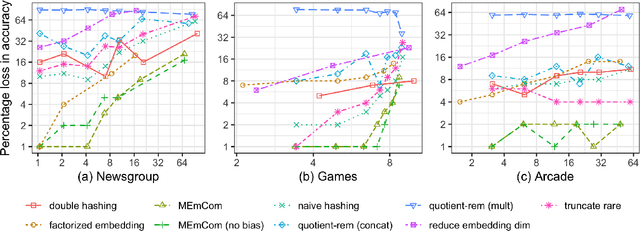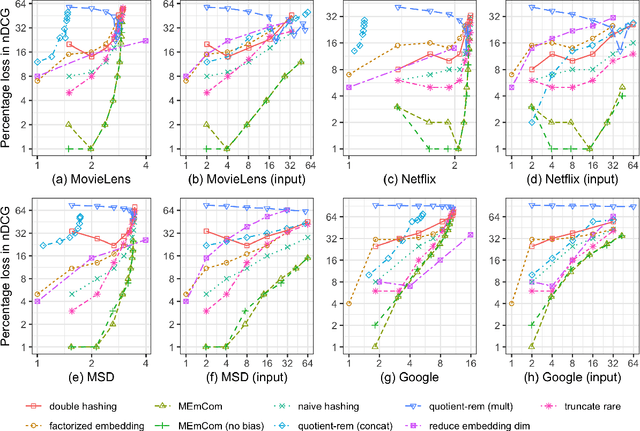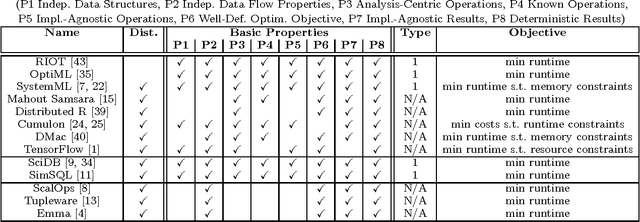Niketan Pansare
Learning Compressed Embeddings for On-Device Inference
Mar 18, 2022



Abstract:In deep learning, embeddings are widely used to represent categorical entities such as words, apps, and movies. An embedding layer maps each entity to a unique vector, causing the layer's memory requirement to be proportional to the number of entities. In the recommendation domain, a given category can have hundreds of thousands of entities, and its embedding layer can take gigabytes of memory. The scale of these networks makes them difficult to deploy in resource constrained environments. In this paper, we propose a novel approach for reducing the size of an embedding table while still mapping each entity to its own unique embedding. Rather than maintaining the full embedding table, we construct each entity's embedding "on the fly" using two separate embedding tables. The first table employs hashing to force multiple entities to share an embedding. The second table contains one trainable weight per entity, allowing the model to distinguish between entities sharing the same embedding. Since these two tables are trained jointly, the network is able to learn a unique embedding per entity, helping it maintain a discriminative capability similar to a model with an uncompressed embedding table. We call this approach MEmCom (Multi-Embedding Compression). We compare with state-of-the-art model compression techniques for multiple problem classes including classification and ranking. On four popular recommender system datasets, MEmCom had a 4% relative loss in nDCG while compressing the input embedding sizes of our recommendation models by 16x, 4x, 12x, and 40x. MEmCom outperforms the state-of-the-art techniques, which achieved 16%, 6%, 10%, and 8% relative loss in nDCG at the respective compression ratios. Additionally, MEmCom is able to compress the RankNet ranking model by 32x on a dataset with millions of users' interactions with games while incurring only a 1% relative loss in nDCG.
Deep Learning with Apache SystemML
Feb 08, 2018Abstract:Enterprises operate large data lakes using Hadoop and Spark frameworks that (1) run a plethora of tools to automate powerful data preparation/transformation pipelines, (2) run on shared, large clusters to (3) perform many different analytics tasks ranging from model preparation, building, evaluation, and tuning for both machine learning and deep learning. Developing machine/deep learning models on data in such shared environments is challenging. Apache SystemML provides a unified framework for implementing machine learning and deep learning algorithms in a variety of shared deployment scenarios. SystemML's novel compilation approach automatically generates runtime execution plans for machine/deep learning algorithms that are composed of single-node and distributed runtime operations depending on data and cluster characteristics such as data size, data sparsity, cluster size, and memory configurations, while still exploiting the capabilities of the underlying big data frameworks.
Declarative Machine Learning - A Classification of Basic Properties and Types
May 19, 2016

Abstract:Declarative machine learning (ML) aims at the high-level specification of ML tasks or algorithms, and automatic generation of optimized execution plans from these specifications. The fundamental goal is to simplify the usage and/or development of ML algorithms, which is especially important in the context of large-scale computations. However, ML systems at different abstraction levels have emerged over time and accordingly there has been a controversy about the meaning of this general definition of declarative ML. Specification alternatives range from ML algorithms expressed in domain-specific languages (DSLs) with optimization for performance, to ML task (learning problem) specifications with optimization for performance and accuracy. We argue that these different types of declarative ML complement each other as they address different users (data scientists and end users). This paper makes an attempt to create a taxonomy for declarative ML, including a definition of essential basic properties and types of declarative ML. Along the way, we provide insights into implications of these properties. We also use this taxonomy to classify existing systems. Finally, we draw conclusions on defining appropriate benchmarks and specification languages for declarative ML.
 Add to Chrome
Add to Chrome Add to Firefox
Add to Firefox Add to Edge
Add to Edge